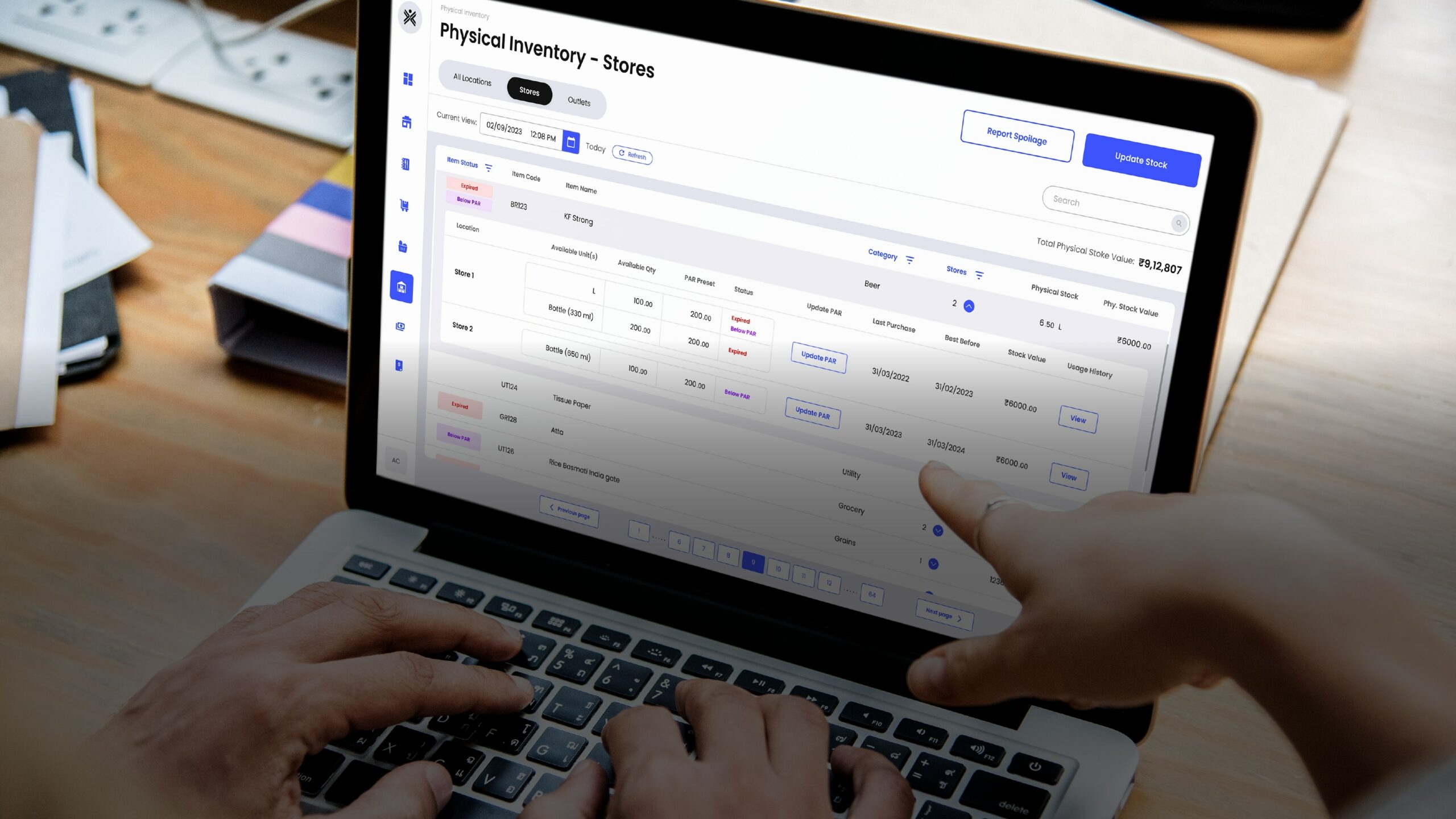Are you passionate about coffee, delicious treats, and creating a warm and inviting space for people to gather? Starting a cafe in India can be a fulfilling and rewarding venture, but it requires careful planning and execution. From crafting a unique concept to navigating legal requirements, this blog will walk you through the essential steps to turn your dream of owning a cafe into a reality.
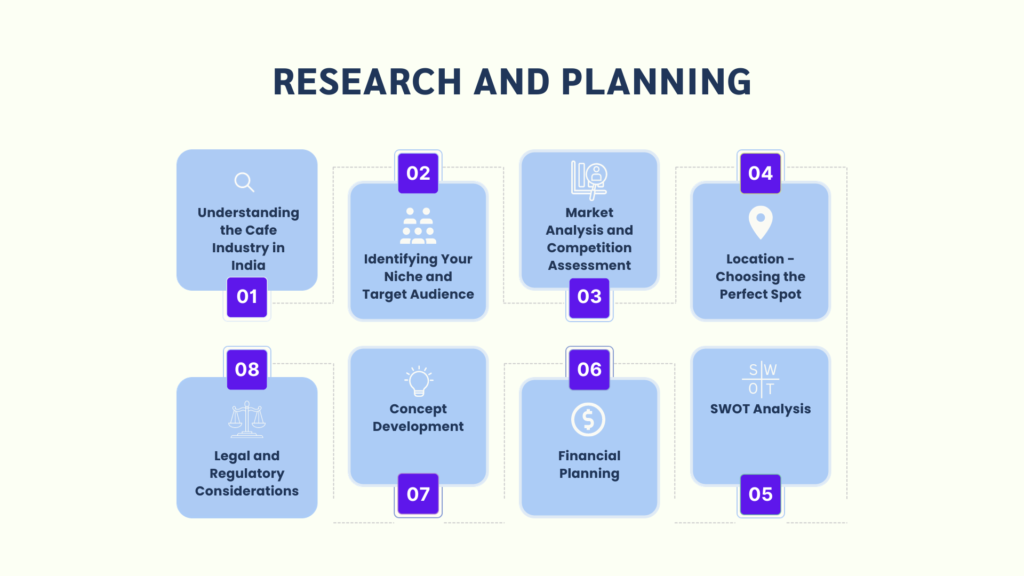
Step 1- Research and Planning
- Understanding the Cafe Industry in India:
Before diving into your cafe venture, it’s essential to have a clear understanding of the cafe industry in India. Look into factors such as current trends, growth rate, and consumer preferences. Some trends to consider might include the rising demand for specialty coffee, the popularity of health-conscious menus, and the emphasis on unique and Instagram-worthy cafe designs.
- Identifying Your Niche and Target Audience:
Determine what sets your cafe apart from others. Are you focusing on artisanal coffee, healthy food options, baked goods, or a specific theme? Your niche will help you carve out a unique identity and attract a specific customer base. Identify your target audience based on demographics, preferences, and lifestyle. For instance, are you targeting students, working professionals, families, or tourists?
- Market Analysis and Competition Assessment:
Conduct thorough market research to understand the demand for cafes in your chosen location. Analyse the demographics, foot traffic, and spending patterns of the area. Investigate the competition – both cafes and other eateries – to identify gaps in the market that your cafe can fill. Look at their menu offerings, pricing strategies, and customer reviews to gain insights.
- Location- Choosing the Perfect Spot:
The location of your cafe can significantly impact its success. Consider factors such as visibility, accessibility, nearby businesses, and the overall ambiance of the area. High foot traffic areas near colleges, office complexes, shopping districts, and tourist attractions tend to be popular choices. Also, assess the competition in the chosen location and evaluate if there’s room for your cafe to thrive.
- SWOT Analysis:
Perform a SWOT (Strengths, Weaknesses, Opportunities, Threats) analysis to assess your cafe’s internal strengths and weaknesses as well as external opportunities and threats. This analysis will help you better understand where your cafe stands in the market and guide your strategic decisions.
- Financial Planning:
As part of your research and planning, create a comprehensive financial plan. Estimate the startup costs, including equipment, furnishings, licences, permits, and initial inventory. Develop a detailed budget for ongoing expenses like rent, utilities, staff salaries, and marketing efforts. This financial planning will help you determine your funding needs and set realistic revenue goals.
- Concept Development:
Based on your research, define the concept and theme of your cafe. This includes your menu offerings, decor, ambiance, and overall customer experience. A well-defined concept will attract customers who resonate with your cafe’s unique identity.
- Legal and Regulatory Considerations:
Research the restaurant licences and permits required to operate a cafe in your chosen location. This might include health permits, food safety licences, and local business licences. Be sure to comply with all legal requirements to avoid potential issues in the future.

Step 2 – How to Create a Unique Brand Identity
- Developing Your Cafe’s Concept and Theme:
Your cafe’s concept and theme form the core of your brand identity. Consider factors like the atmosphere you want to create, the type of experience you want customers to have, and the emotions you want to evoke. Are you going for a cosy rustic vibe, a modern minimalist look, or a quirky and vibrant ambiance? Your concept should align with your target audience’s preferences.
- Crafting an Appealing Menu:
Design a menu that reflects your cafe’s concept while catering to the tastes of your target audience. Offer a diverse range of options, including beverages (coffee, tea, juices, etc.), food (breakfast, sandwiches, desserts, etc.), and potentially even unique signature items. Consider incorporating local flavours or healthy choices based on the preferences of your target market.
- Designing a Memorable Logo and Visual Identity:
Your logo is a visual representation of your cafe’s brand. It should be simple, unique, and easily recognizable. Consider working with a professional designer to create a logo that encapsulates your cafe’s concept. Your chosen colour palette, typography, and design elements should also be consistent across all branding materials, from menus to signage.
- Establishing an Online Presence: Website and Social Media:
In today’s digital age, having a strong online presence is crucial for attracting customers. Engage with customers on social media platforms like Instagram, Facebook, Twitter, and others that align with your target audience. Regularly share visually appealing content, including images of your food and drinks, behind-the-scenes glimpses, special promotions, and customer testimonials. Social media can help you build a community of loyal followers and generate excitement around your cafe.
- Incorporating Consistency:
Consistency is key to building a strong brand identity. Ensure that your concept, theme, menu offerings, visual elements, and communication style remain consistent across all touchpoints – both online and offline. This consistency creates a cohesive and memorable brand experience for your customers.
- Engaging Customer Interaction:
Encourage customer interaction by responding promptly to reviews, comments, and messages on your website and social media. Positive interactions and timely responses build trust and a sense of community around your brand.
- Branding Materials:
Extend your brand identity to physical branding materials such as menus, business cards, signage, packaging, and even staff uniforms. These materials should reflect the overall look and feel of your cafe, reinforcing your brand’s identity in every aspect of the customer experience.
- Storytelling:
Share the story behind your cafe’s inception, its name, and the inspiration behind the concept. Storytelling adds a personal touch to your brand and helps customers connect with your cafe on a deeper level. Remember that your brand identity should resonate with your target audience and differentiate your cafe in a competitive market. By carefully crafting your cafe’s concept, menu, visual identity, and online presence, you’ll create a unique and memorable brand that attracts customers and fosters loyalty.
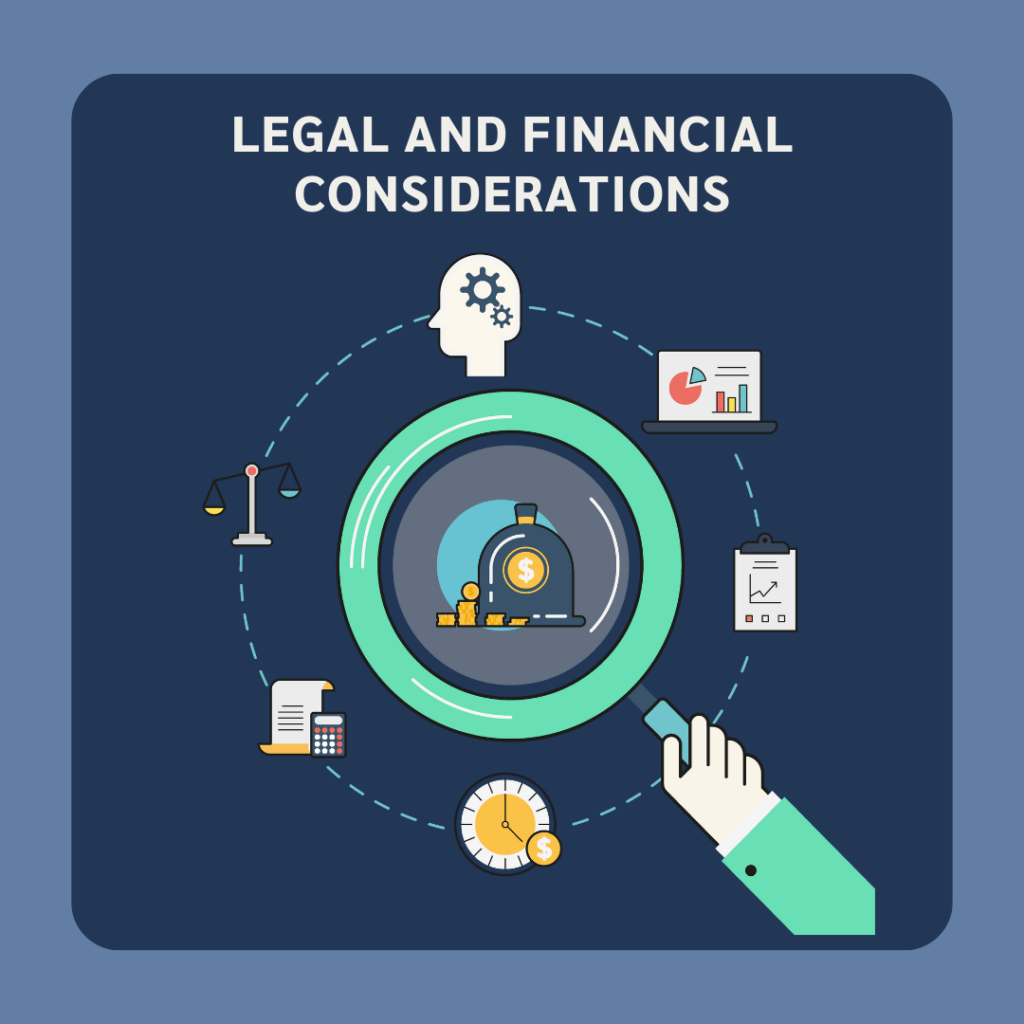
Step 3 – Legal and Financial Considerations
- Registering Your Cafe Business:
Choose a Business Structure: Decide on the legal structure of your cafe, such as a sole proprietorship, partnership, limited liability partnership (LLP), or private limited company. Each structure has its own implications in terms of liability, taxation, and ownership.
- Business Name Registration: Choose a unique and catchy name for your cafe and check if it’s available for registration. Register your business name with the relevant authorities.
- Business Registration: Register your cafe business with the appropriate government body, such as the Registrar of Companies (RoC) for a company or with the local municipal corporation for other structures.
- Obtaining Licences and Permits:
- FSSAI License: Obtain the Food Safety and Standards Authority of India (FSSAI) licence, which is mandatory for any food-related business to ensure compliance with food safety and hygiene regulations.
- Local Municipality Licence: Acquire a trade licence from your local municipal corporation. This licence ensures that your business complies with local business regulations.
- Health Department Permits: Depending on your state, you might need specific health permits that certify your cafe’s compliance with health and hygiene standards.
- Fire Department NOC: If your cafe has a kitchen, you may need a No Objection Certificate from the local fire department to ensure fire safety compliance.
- Music Licence: If you plan to play music in your cafe, consider obtaining a licence from the relevant copyright organisations.
- Environmental Clearance (if applicable): If your cafe could potentially impact the environment (waste disposal, emissions, etc.), you might need environmental clearance from the concerned authority.
- Signage Licence: If you plan to have outdoor signage, you might need a licence from local authorities.
- Setting Up a Solid Financial Plan:
- Business Plan: Develop a detailed business plan that outlines your cafe’s goals, target audience, menu offerings, marketing strategies, and financial projections.
- Financial Projections: Estimate your cafe’s revenue, expenses, and profits over the next few years. Consider factors like operating costs, staff salaries, rent, utilities, and marketing expenses.
- Budget Allocation: Allocate funds for various aspects of your cafe, including interior setup, equipment purchase, initial inventory, marketing, and contingency funds.
- Estimating Startup Costs and Ongoing Expenses:
- Startup Costs: Calculate the initial costs required to set up your cafe. This includes costs for interior design, furnishings, kitchen equipment, licenses, permits, initial stock, and marketing materials.
- Ongoing Expenses: Determine the recurring expenses such as rent, utilities (electricity, water, gas), staff salaries, ingredient costs, maintenance, and marketing expenses.
- Contingency Fund: Set aside a contingency fund to cover unforeseen expenses that might arise during the initial stages of your cafe’s operation.
- Funding Sources: Evaluate your funding options, which could include personal savings, bank loans, investors, or grants. Choose the most suitable option based on your financial situation and business plan.

Step 4 – Interior Design and Ambiance
- Creating a Cozy and Inviting Atmosphere:
- Warm Welcome: The entrance should make customers feel welcome. Use attractive signage, a comfortable waiting area, and possibly some greenery to create a positive first impression.
- Seating Arrangement: Offer a variety of seating options, including comfortable couches, cushioned chairs, bar stools, and communal tables. Cater to different preferences and group sizes.
- Space Utilisation: Optimise your space for efficient movement. Avoid overcrowding and ensure that customers have enough room to move around comfortably.
- Layout and Furniture Selection:
- Flow: Design the restaurant layout to guide customers through the cafe logically. Place the counter where customers can easily see the menu and place orders.
- Comfort: Choose comfortable and ergonomic furniture that encourages customers to stay longer. Consider using cushioned chairs, padded booths, and cosy corners.
- Flexibility: Provide a mix of seating options to cater to individuals, couples, and groups. Incorporate movable furniture that can be rearranged for larger parties or events.
- Lighting, Colors, and Decor:
- Lighting: Lighting sets the mood. Use a mix of natural light, pendant lights, chandeliers, and soft ambient lighting. Consider dimmable lights to adjust the ambiance and restaurant design during different times of the day.
- Colours: Choose a colour scheme that aligns with your cafe’s concept. Warm and earthy tones create a cosy feel, while brighter colours can give a more vibrant atmosphere.
- Decor: Incorporate decor that compliments your cafe’s theme. This could include wall art, framed quotes, plants, and unique decorative items that add character.
- The Role of Music and Art:
- Music: Select a playlist that matches your cafe’s vibe. Soft background music can create a soothing atmosphere, while livelier tunes can energise the space during peak hours. Ensure the volume is at a level where customers can comfortably converse.
- Art and Visuals: Display local artwork, photography, or murals to add visual interest and a sense of community. Art can also serve as a conversation starter and create a unique atmosphere.
- Accessibility and Comfort:
- Wheelchair Accessibility: Ensure that your cafe is wheelchair accessible with ramps or elevators if needed. Consider the layout for easy manoeuvrability.
- Restrooms: Keep restrooms clean, well-lit, and easily accessible. Consider adding a touch of decor to extend the ambiance even to this space.
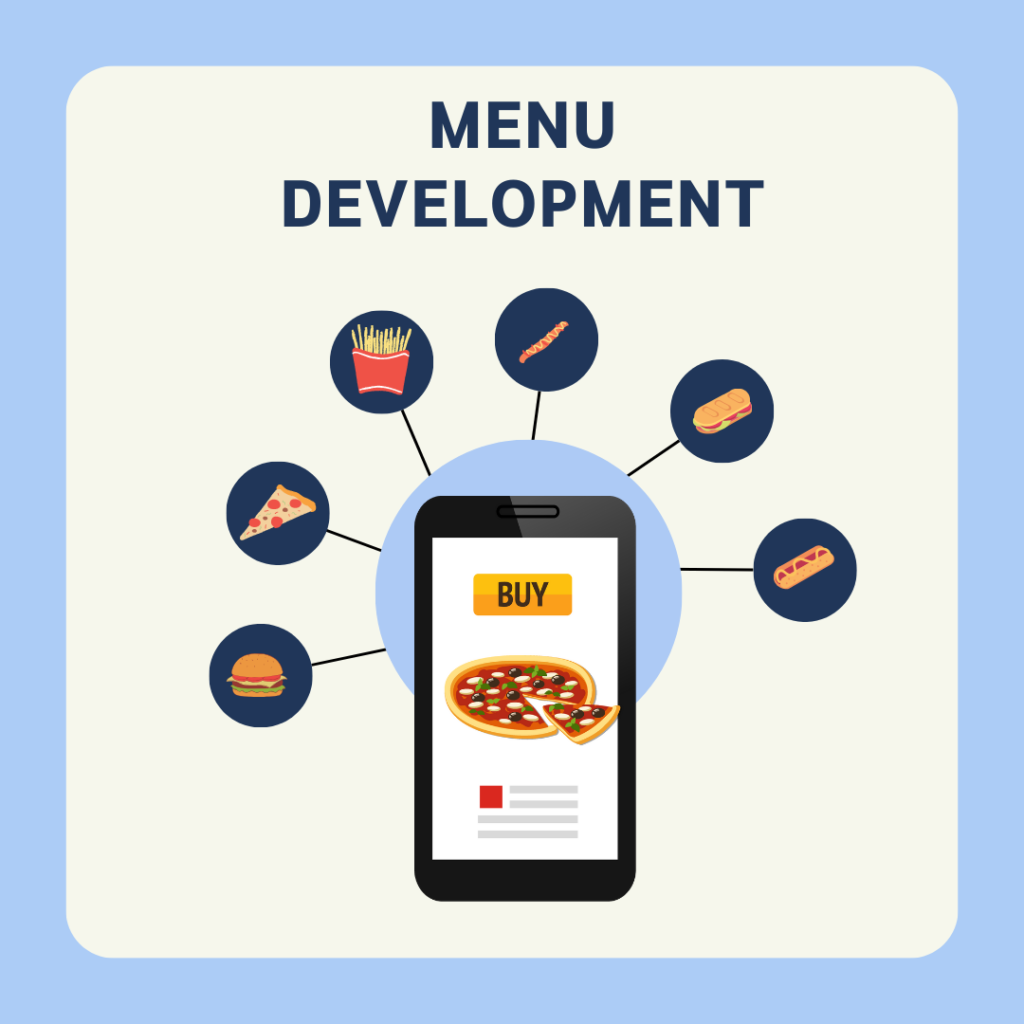
Step 5- Menu Development
- Crafting a Diverse Menu to Cater to Different Tastes:
- Coffee and Beverages: Design a range of coffee options, including espresso-based drinks, brewed coffee, teas, and specialty beverages. Offer choices for different taste preferences, such as strong, mild, sweet, and savoury.
- Food Options: Create a diverse food menu that includes breakfast items, sandwiches, salads, pastries, and desserts. Consider vegetarian, vegan, and gluten-free options to cater to a broader audience.
- Variety: Provide a mix of flavours, textures, and cuisines to cater to different customer preferences. Offer options for comfort food, health-conscious choices, and indulgent treats.
- Emphasising Quality and Freshness:
- Ingredient Sourcing: Source high-quality, fresh ingredients from reliable suppliers. Emphasise the use of local and seasonal produce whenever possible.
- Food Preparation: Ensure that all food items are prepared to order, maintaining the quality and freshness of each dish. Avoid pre-packaging items if they can be made on-site.
- Consistency: Maintain consistency in portion sizes, presentation, and taste across all menu items. This consistency builds customer trust and loyalty.
- Incorporating Local Flavors and Specialties:
- Regional Influences: Infuse your menu with local flavours and ingredients that reflect the culture and cuisine of the region. This can make your cafe stand out and attract customers looking for unique experiences.
- Seasonal Specials: Introduce seasonal specials that highlight ingredients that are currently in season. These limited-time offerings can generate excitement and encourage repeat visits.
- Signature Dishes: Create signature dishes or drinks that are exclusive to your cafe. These items can become customer favourites and set you apart from competitors.
- Presentation and Plating:
- Visual Appeal: Pay attention to the presentation of each dish. A visually appealing presentation enhances the overall dining experience and encourages customers to share photos on social media.
- Plating Techniques: Train your kitchen staff in effective plating techniques that showcase the colours, textures, and components of each dish.
- Tasting and Quality Control:
- Regular Tastings: Conduct regular tastings of menu items to ensure that they meet your quality standards and are consistently delicious.
- Customer Feedback: Encourage customer feedback on menu items. This can provide insights into what’s working and where improvements can be made.
- Menu Pricing:
- Cost Analysis: Conduct a thorough cost analysis for each menu item to ensure that pricing covers ingredients, overhead, and a reasonable profit margin.
- Competitive Pricing: Research the pricing of similar menu items in your area to ensure that your prices are competitive.
- Innovation and Adaptation:
- Innovative Additions: Keep your menu fresh and exciting by periodically introducing new items. This encourages repeat visits from regular customers and attracts new ones.
- Adapting to Feedback: Listen to customer feedback and be willing to make adjustments to your menu based on their preferences and suggestions.
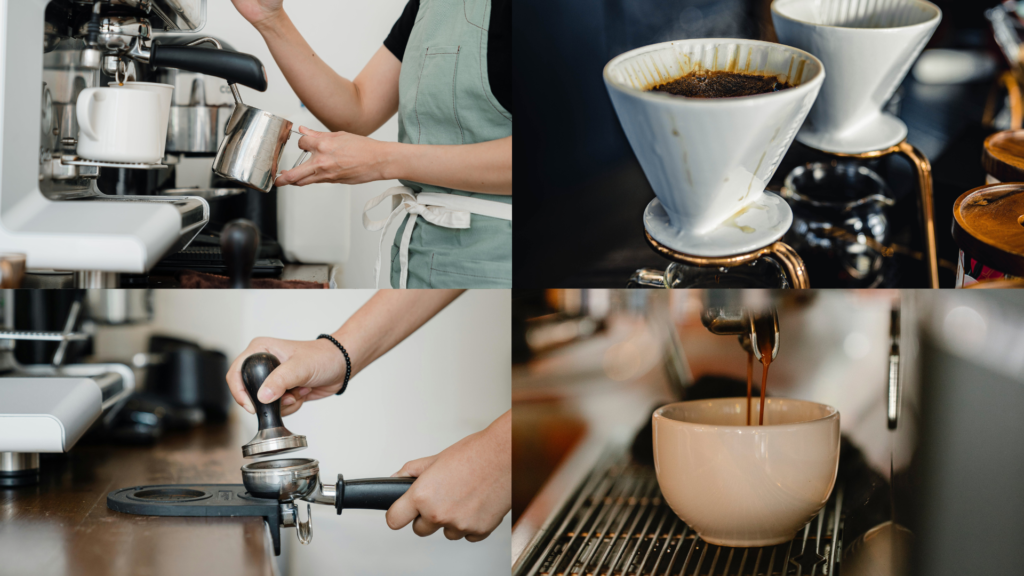
Step 6- Sourcing Equipment and Ingredients
- Choosing the Right Appliances:
- Espresso Machine and Coffee Equipment: If coffee is a focus of your cafe, invest in a quality espresso machine, grinders, and brewing equipment. The choice of these items can significantly impact the taste and consistency of your coffee offerings.
- Kitchen Equipment: Depending on your menu, ensure you have appropriate kitchen appliances such as ovens, microwaves, toasters, blenders, and refrigeration units.
- Beverage Dispensers: For cold beverages, consider beverage dispensers for juices, iced teas, and other refreshments.
- Restaurant Management System: Invest in a reliable restaurant management system that handles orders, payments, and tracking inventory. This will help streamline operations and improve customer service.
- Furniture and Decor: Beyond functional equipment, invest in furniture, decor, and furnishings that align with your cafe’s theme and enhance the overall atmosphere.
- Selecting High-Quality Ingredients:
- Coffee Beans: If coffee is a central part of your cafe, source high-quality coffee beans from reputable local or international suppliers. Consider factors like origin, roast level, and flavour profiles.
- Food Ingredients: Choose fresh, locally sourced ingredients for your food offerings. Quality ingredients contribute to the taste and reputation of your menu items.
- Bakery and Dessert Ingredients: If your cafe serves baked goods or desserts, ensure you use premium ingredients to maintain the quality and taste of these items.
- Beverages: Source quality teas, herbal infusions, and other beverage ingredients that align with your cafe’s theme and appeal to your target audience.
- Building Relationships with Suppliers:
- Research: Identify potential suppliers through online research, industry events, and referrals from other cafe owners.
- Communication: Establish clear lines of communication with your suppliers. Discuss your requirements, quality expectations, and delivery schedules.
- Sample Testing: Before finalising contracts, request samples of ingredients or products to evaluate their quality and compatibility with your menu.
- Negotiation: Negotiate pricing, payment terms, and delivery arrangements that work for both parties. Establish a mutually beneficial partnership.
- Consistency: Once you’ve chosen suppliers, maintain consistent quality by regularly checking incoming ingredients and addressing any issues promptly.
- Feedback: Provide constructive feedback to your suppliers to ensure continuous improvement in the quality of the products you receive.
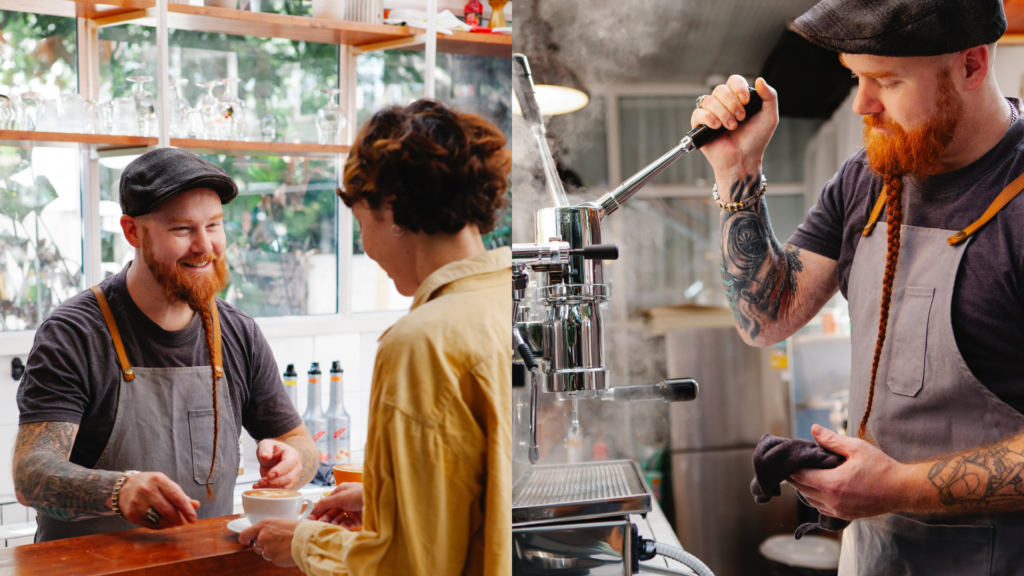
Step 7- Hiring and Training Staff
The staff you might need –
- Cafe Manager: The cafe manager oversees day-to-day operations, manages staff, handles customer service, monitors inventory, and ensures the smooth functioning of the cafe.
- Baristas: Baristas are responsible for preparing coffee and other beverages according to the cafe’s standards. They should have strong knowledge of coffee brewing techniques, be able to create latte art, and provide excellent customer service.
- Cooks/Chefs: If your cafe offers a food menu, cooks or chefs are responsible for preparing and presenting food items according to your cafe’s recipes and quality standards.
- Servers/Waitstaff: Servers take customer orders, serve food and beverages, handle payments, and maintain a clean and organised dining area. They should be knowledgeable about the menu and capable of providing recommendations.
- Cashiers: Cashiers handle transactions, process orders, and ensure accurate billing. They should have good math skills and be familiar with the cafe’s POS system.
- Kitchen Assistants: Kitchen assistants support the cooks and chefs by prepping ingredients, cleaning utensils, and maintaining a clean and organised kitchen area.
- Cleaning Staff: Cleaning staff ensure that the cafe’s interior, tables, chairs, kitchen, and restrooms are clean and well-maintained throughout the day.
- Cross-Training:
Consider cross-training employees in multiple roles. This provides flexibility in staffing and helps staff members gain a broader understanding of the cafe’s operations.
- Training:
Implement comprehensive training programs for each role to ensure that staff members are well-equipped to carry out their responsibilities effectively. Training should cover customer service, product knowledge, hygiene practices, and any specific tasks related to the role.
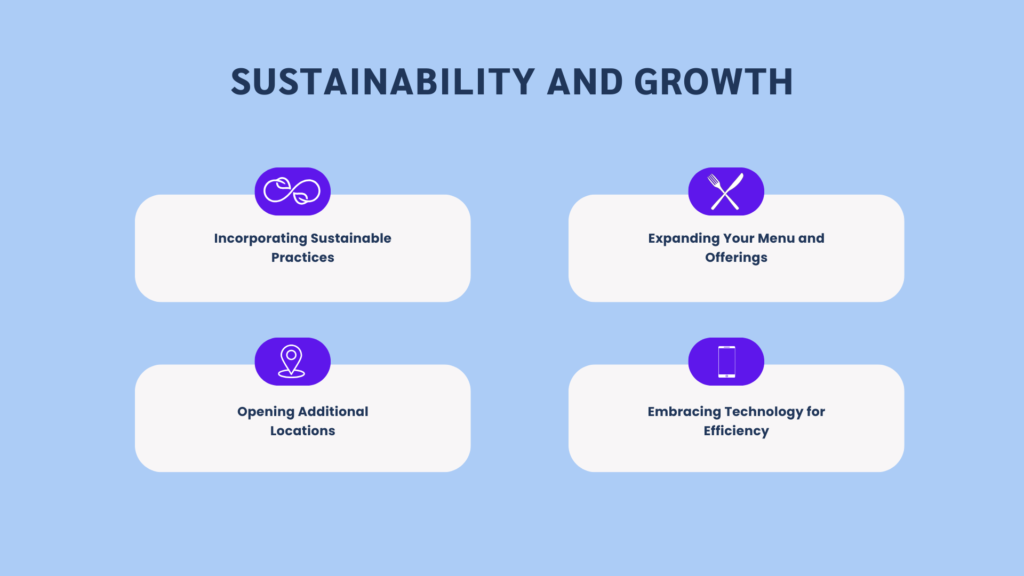
Step 8- Sustainability and Growth
- Incorporating Sustainable Practices:
- Sourcing: Continue to prioritise local and sustainable sourcing for ingredients, reducing the carbon footprint and supporting local farmers.
- Waste Reduction: Implement waste reduction practices such as composting food scraps, adopting digital menus, etc.
- Expanding Your Menu and Offerings:
- Seasonal Specials: Continue introducing seasonal specials to keep your menu fresh and exciting.
- Collaborations: Collaborate with local suppliers or chefs for special events or limited-time menu collaborations.
- Opening Additional Locations:
- Market Research: Conduct thorough market research to identify potential locations for expansion. Consider areas with similar demographics and demand.
- Replicating Success: Use the lessons learned from your first cafe to streamline the opening of additional locations.
- Consistency: Maintain a consistent brand identity, menu, and quality across all locations to build customer loyalty.
- Scaling Sustainability: Apply sustainable practices to new locations, showcasing your commitment to environmental responsibility.
- Embracing Technology for Efficiency:
- Digital Menu: Incorporate a digital menu that allows customers to place orders, pay for orders, earn rewards, and stay updated on promotions to enhance their experience and ease.
- Restaurant Management Systems: Invest in an advanced restaurant management system to streamline operations and track stock efficiently.

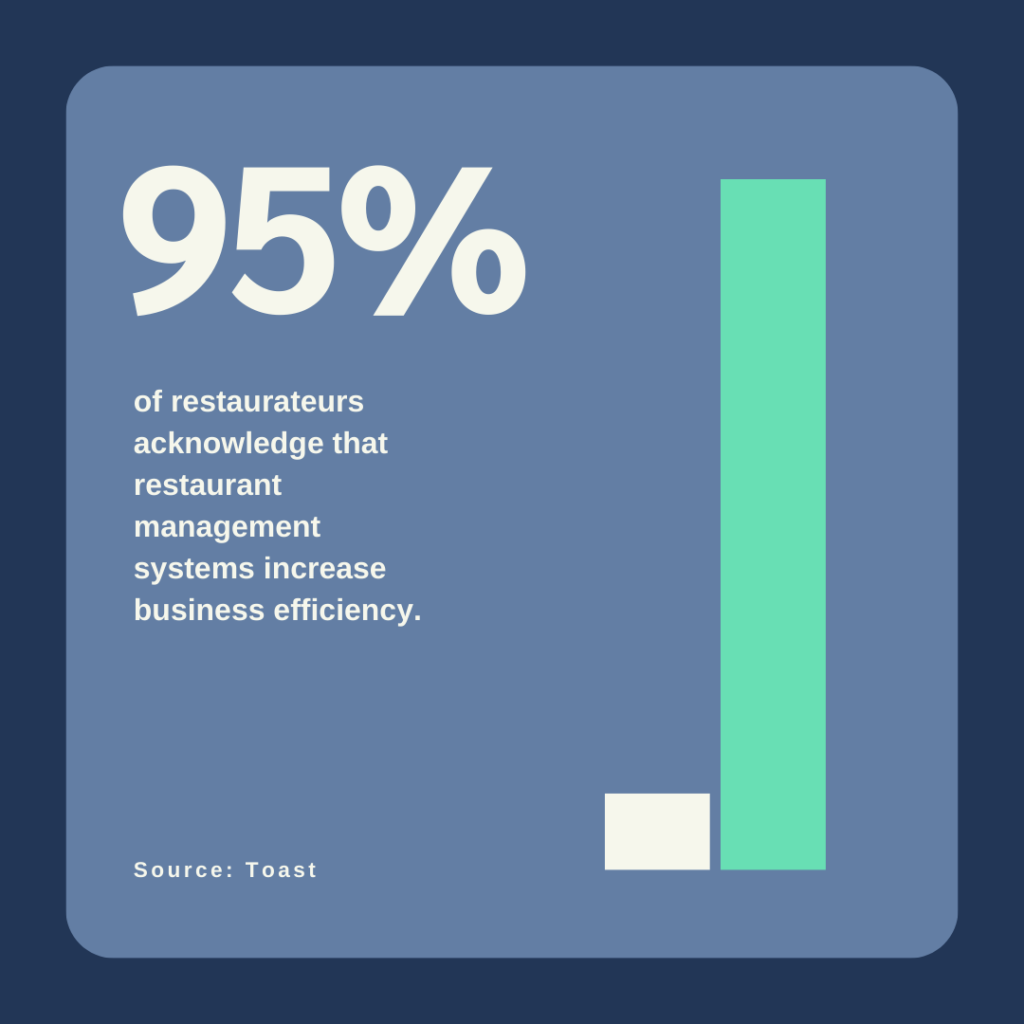
- Online Ordering: Implement an efficient online ordering system for both pickup and delivery to cater to changing customer preferences.
- Social Media and Marketing: Utilise social media and digital marketing strategies to engage with customers, promote offerings, and increase your cafe’s visibility.
- Customer Data: Leverage customer data collected through technology to tailor your offerings and marketing efforts to customer preferences.

We understand starting a cafe can be a fulfilling journey filled with its share of challenges and rewards. By following this comprehensive framework, you’ll be equipped with the knowledge and strategies necessary to embark on this exciting entrepreneurial venture. Remember, a successful cafe isn’t just about serving great coffee and food – it’s about creating a haven where people can gather, connect, and make cherished memories. So, brew your passion with dedication, and watch your cafe become a beloved destination in the hearts of your patrons.



